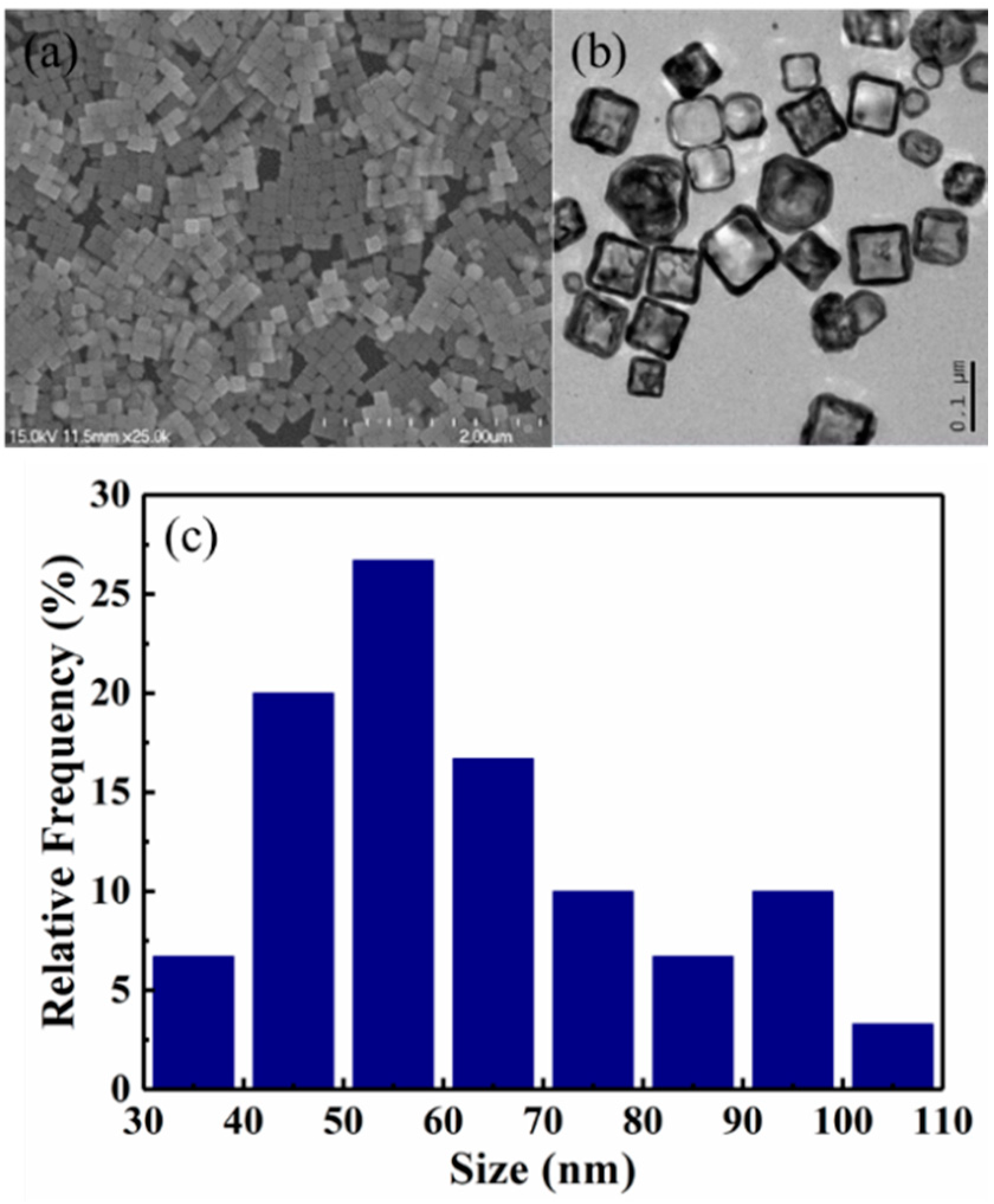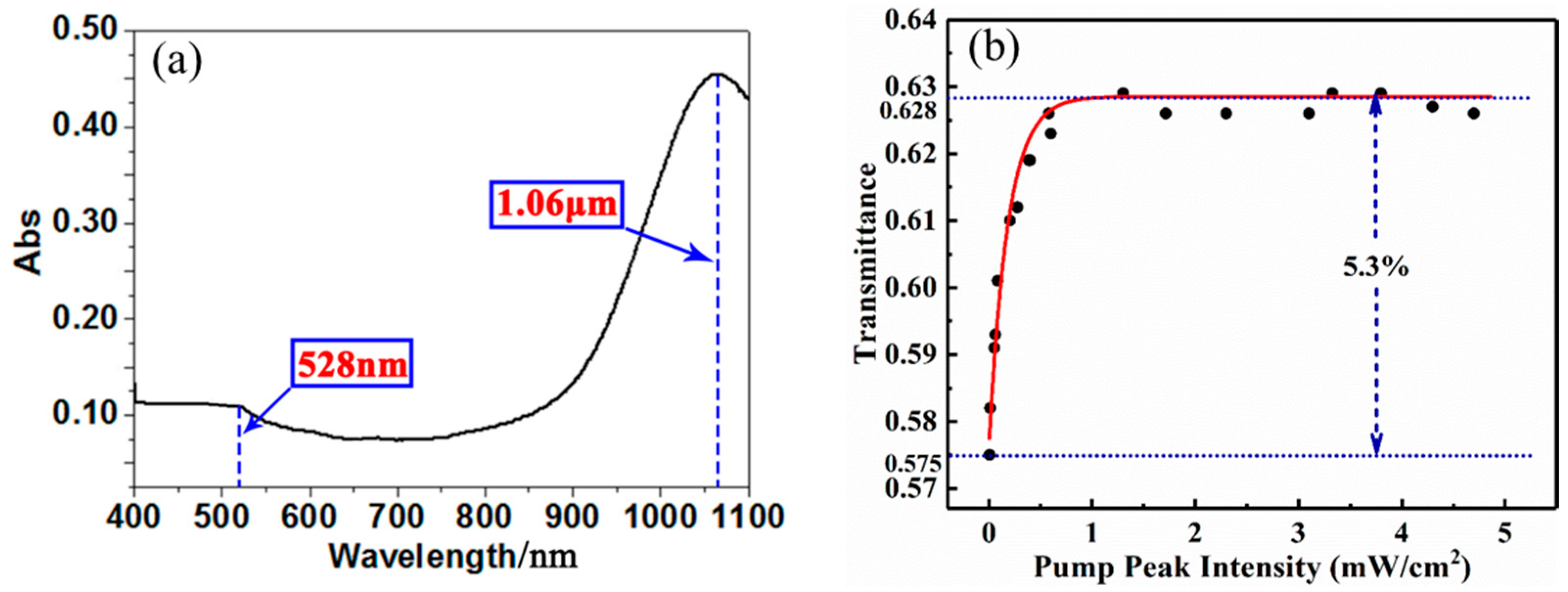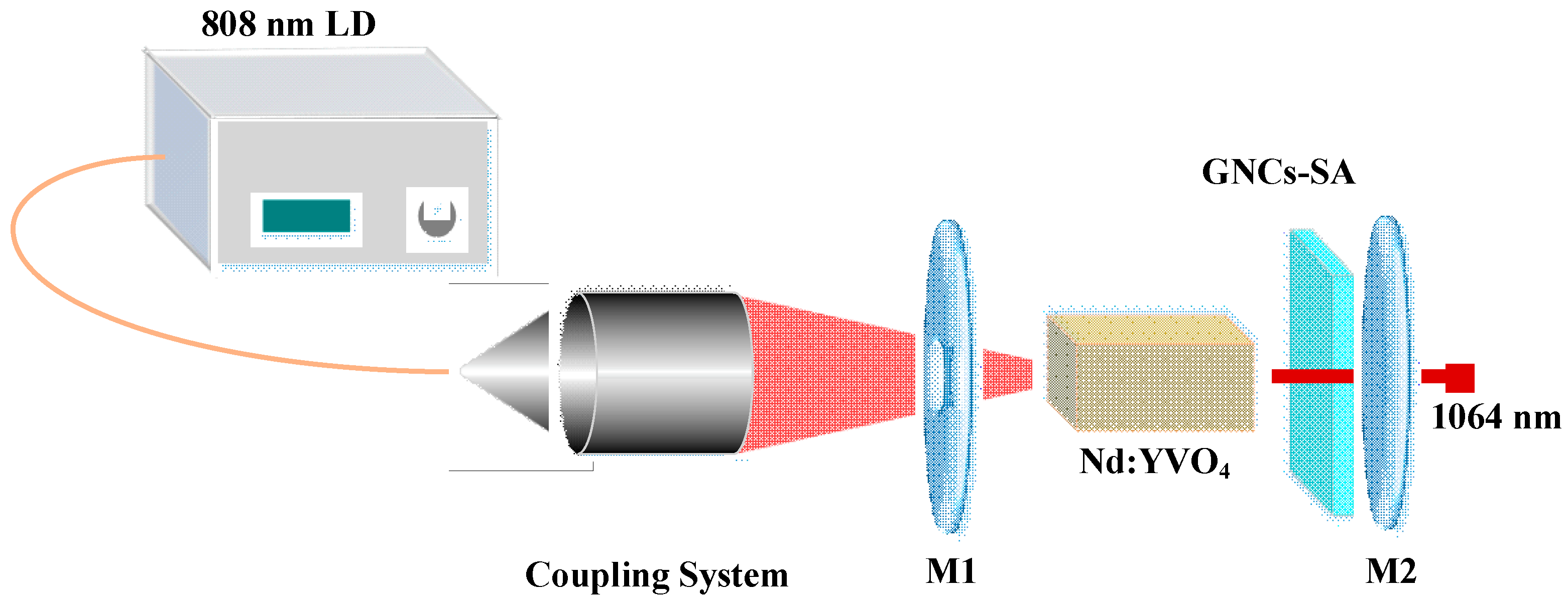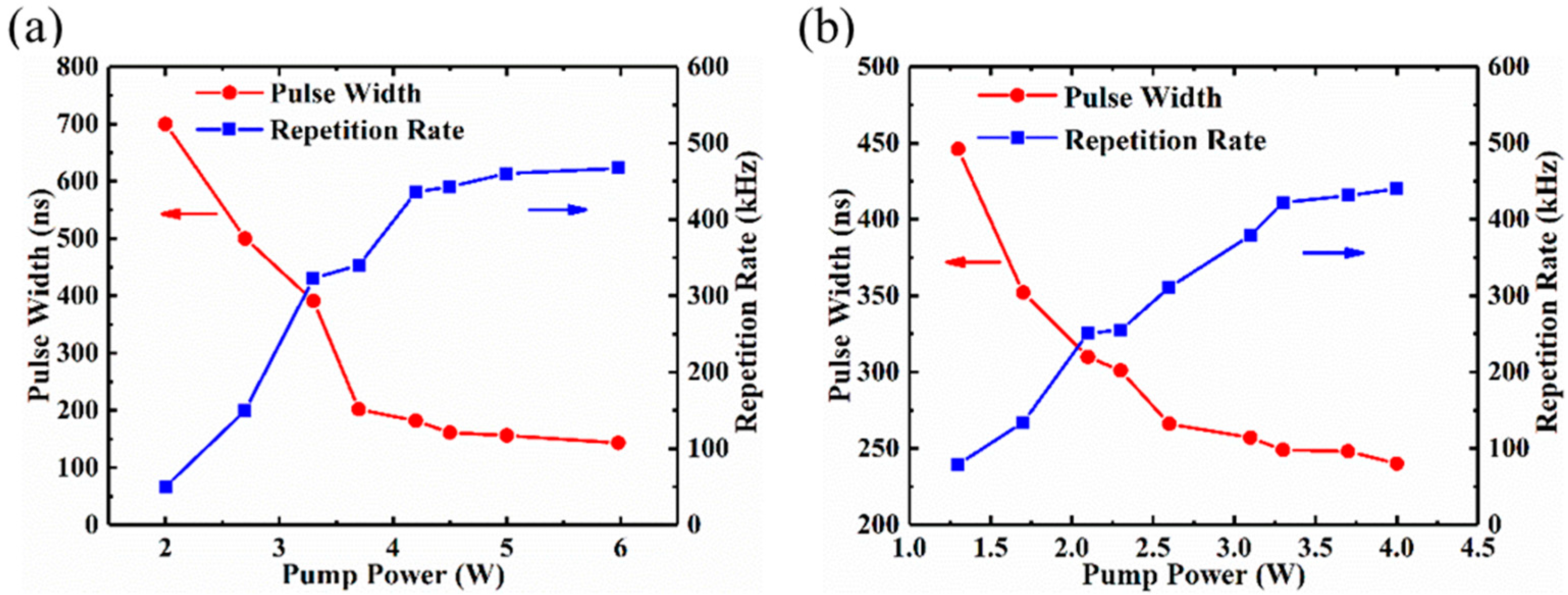Gold Nanocages as Saturable Absorbers for Passively Q-Switched Nd:YVO4 Lasers with Optimized Performance
Abstract
:1. Introduction
2. Preparation and the Characterization of the GNCs
3. Experimental Setup
4. Experimental Results and Discussion
5. Conclusions
Author Contributions
Funding
Conflicts of Interest
References
- Kajava, T.T.; Gaeta, A.L. Q switching of a diode-pumped Nd:YAG laser with GaAs. Opt. Lett. 1996, 21, 1244–1246. [Google Scholar] [CrossRef] [PubMed]
- Keller, U.; Miller, D.A.B.; Boyd, G.D.; Chiu, T.H.; Ferguson, J.F.; Asom, M.T. Solid-state low-loss intracavity saturable absorber for Nd:YLF lasers: An antiresonant semiconductor Fabry-Perot saturable absorber. Opt. Lett. 1992, 17, 505–507. [Google Scholar] [CrossRef] [PubMed]
- Liu, H.; Zhou, S.H.; Chen, Y.C. High-power monolithic unstable-resonator solid-state laser. Opt. Lett. 1998, 23, 451–453. [Google Scholar] [CrossRef] [PubMed]
- Martinez, S.; Lamikiz, A.; Ukar, E.; Calleja, A.; Arrizubieta, J.A.; Lopez de Lacalle, L.N. Analysis of the regimes in the scanner-based laser hardening process. Opt. Lasers Eng. 2017, 90, 72–80. [Google Scholar] [CrossRef]
- Calleja, A.; Tabernero, I.; Ealo, J.; Campa, F.; Lamikiz, A.; Lopez de Lacalle, L.N. Feed rate calculation algorithm for the homogeneous material deposition of blisk blades by 5-axis laser cladding. Int. J. Adv. Manuf. Technol. 2014, 74, 1219–1228. [Google Scholar] [CrossRef]
- Huang, J.Y.; Liang, H.C.; Su, K.W.; Chen, Y.F. High power passively Q-switched ytterbium fiber laser with Cr4+:YAG as a saturable absorber. Opt. Express 2007, 15, 473–479. [Google Scholar] [CrossRef]
- Yao, B.; Tian, Y.; Li, G.; Wang, Y.Z. InGaAs/GaAs saturable absorber for diode-pumped passively Q-switched dual-wavelength Tm:YAP lasers. Opt. Express 2010, 18, 13574–13579. [Google Scholar] [CrossRef]
- Okhotnikov, O.; Grudinin, A.; Pessa, M. Ultra-fast fibre laser systems based on SESAM technology: New horizons and applications. New J. Phys. 2004, 6, 177. [Google Scholar] [CrossRef]
- Sun, Y.J.; Lee, C.K.; Xu, J.L.; Zhu, Z.J.; Wang, Y.Q.; Gao, S.F.; Xia, H.P.; You, Z.Y.; Tu, C.Y. Passively Q-switched tri-wavelength Yb3+:GdAl3(BO3)4 solid-state laser with topological insulator Bi2Te3 as saturable absorber. Photonics Res. 2015, 3, A97–A101. [Google Scholar] [CrossRef] [Green Version]
- Chu, H.W.; Zhao, S.Z.; Li, T.; Yang, K.J.; Li, G.Q.; Li, D.C.; Zhao, J.; Qiao, W.C.; Xu, J.Q.; Hang, Y. Dual-Wavelength Passively Q-Switched Nd, Mg:LiTaO3 Laser With a Monolayer Graphene as Saturable Absorber. IEEE J. Sel. Top. Quantum Electron. 2015, 21, 343–347. [Google Scholar] [CrossRef]
- Sun, Z.P.; Hasan, T.; Torrisi, F.; Popa, D.; Privitera, G.; Wang, F.Q.; Bonaccorso, F.; Basko, D.M.; Ferrari, A.C. Graphene mode-locked ultrafast laser. ACS Nano 2010, 4, 803–810. [Google Scholar] [CrossRef] [PubMed] [Green Version]
- Wang, S.X.; Yu, H.H.; Zhang, H.J.; Wang, A.Z.; Zhao, M.W.; Chen, Y.X.; Mei, L.M.; Wang, J.Y. Broadband few-layer MoS2 saturable absorbers. Adv. Mater. 2014, 26, 3538–3544. [Google Scholar] [CrossRef] [PubMed]
- Zhang, B.T.; Lou, F.; Zhao, R.W.; He, J.L.; Li, J.; Su, X.C.; Ning, J.; Yang, K.J. Exfoliated layers of black phosphorus as saturable absorber for ultrafast solid-state laser. Opt. Lett. 2015, 40, 3691–3694. [Google Scholar] [CrossRef] [PubMed]
- Wu, D.D.; Peng, J.; Cai, Z.P.; Weng, J.; Luo, Z.Q.; Chen, N.; Xu, H.Y. Gold nanoparticles as a saturable absorber for visible 635 nm Q-switched pulse generation. Opt. Express 2015, 23, 24071–24076. [Google Scholar] [CrossRef]
- Kim, K.H.; Griebner, U.; Herrmann, J. Theory of passive mode locking of solid-state lasers using metal nanocomposites as slow saturable absorbers. Opt. Lett. 2012, 37, 1490–1492. [Google Scholar] [CrossRef]
- El-Sayed, M.A. Some interesting properties of metals confined in time and nanometer space of different shapes. Acc. Chem. Res. 2001, 34, 257–264. [Google Scholar] [CrossRef]
- Scarabelli, L.; Puchau, M.C.; Casares, J.G.; Langer, J.; Marzán, L.L. monodisperse gold nanotriangles: Size control, large-scale self assembly, and performance in surface-enhanced Raman scattering. ACS Nano 2014, 8, 5833–5842. [Google Scholar] [CrossRef]
- Ebbesen, T.W.; Genet, C. Light in tiny holes. Nature 2007, 445, 39–46. [Google Scholar]
- Kim, K.H.; Husakou, A.; Herrmann, J. Linear and nonlinear optical characteristics of composites containing metal nanoparticles with different sizes and shapes. Opt. Express 2010, 18, 7488–7496. [Google Scholar] [CrossRef]
- Kang, Z.; Guo, X.Y.; Jia, Z.X.; Xu, Y.; Liu, L.; Zhao, D.; Qin, G.S.; Qin, W.P. Gold nanorods as saturable absorbers for all-fiber passively Q-switched erbium-doped fiber laser. Opt. Mater. Express 2013, 3, 1986–1991. [Google Scholar] [CrossRef]
- Fan, D.F.; Mou, C.B.; Bai, X.K.; Wang, S.F.; Chen, N.; Zeng, X.L. Passively Q-switched erbium-doped fiber laser using evanescent field interaction with gold-nanosphere based saturable absorber. Opt. Express 2014, 22, 18537–18542. [Google Scholar] [CrossRef] [PubMed] [Green Version]
- Zhang, H.N.; Liu, J. Gold nanobipyramids as saturable absorbers for passively Q-switched laser generation in the 1.1 μm region. Opt. Lett. 2016, 41, 1150–1152. [Google Scholar] [CrossRef] [PubMed]
- Song, T.; Feng, C.; Chen, X.H.; Wang, Q.P.; Qin, G.S.; Qin, W.P.; Gao, X.J.; Dun, Y.Y.; Li, P. Gold nanorods as a saturable absorber for passively Q-switching Nd:YAG lasers at 1064.3 and 1112 nm. Laser Phys. Lett. 2017, 14, 055808. [Google Scholar] [CrossRef]
- Bai, J.X.; Li, P.; Chen, X.H.; Lei, G.; Wang, L.L.; Liu, B.H. Diode-pumped passively Q-switched Nd:YAG ceramic laser with a gold nanotriangles saturable absorber at 1 µm. Appl. Phys. Express 2017, 10, 082701. [Google Scholar] [CrossRef]
- Wang, L.L.; Chen, X.H.; Bai, J.X.; Liu, B.H.; Hu, Q.Y.; Li, P. Au nanocages/SiO2 as saturable absorbers for passively Q-switched all-solid-state laser. Mater. Res. Express 2018, 5, 045043. [Google Scholar] [CrossRef]
- Bai, J.X.; Li, P.; Guo, L.; Zhang, B.T.; Hu, Q.Y.; Wang, L.L.; Liu, B.H.; Chen, X.H. Au nanocage/SiO2 saturable absorber for passive Q-switching Yb-doped fiber laser. Laser Phys. 2018, 28, 055109. [Google Scholar] [CrossRef]
- Hu, Q.Y.; Li, P.; Zhang, B.T.; Liu, B.H.; Wang, L.L.; Chen, X.H. Passively Q-switched Yb-doped dual-wavelength fiber laser based on a gold-nanocage saturable absorber. Appl. Opt. 2018, 57, 8242–8248. [Google Scholar] [CrossRef]
- Hu, M.; Petrova, H.; Chen, J.Y.; McLellan, J.M.; Siekkinen, A.R.; Marquez, M.; Li, X.D.; Xia, Y.N.; Hartland, G.V. Ultrafast laser studies of the photothermal properties of gold nanocages. J. Phys. Chem. B 2006, 110, 1520–1524. [Google Scholar] [CrossRef]
- Chen, J.Y.; Wiley, B.; Li, Z.Y.; Campbell, D.; Saeki, F.; Cang, H.; Au, L.; Lee, J.; Li, X.D.; Xia, Y.N. Gold Nanocages: Engineering Their Structure for Biomedical Applications. Adv. Mater. 2005, 17, 2255–2261. [Google Scholar] [CrossRef]
- Wang, H.; Brandl, D.W.; Nordlander, P.; Halas, N.J. Plasmonic nanostructures: Artificial molecules. Acc. Chem. Res. 2007, 40, 53–62. [Google Scholar] [CrossRef]
- Li, Q.R.; Wei, C.; Chi, H.; Zhou, L.Q.; Zhang, H.; Huang, H.; Liu, Y. Au nanocages saturable absorber for 3-µm mid-infrared pulsed fiber laser with a wide wavelength tuning range. Opt. Express 2019, 27, 30350–30359. [Google Scholar] [CrossRef] [PubMed]
- Skrabalak, S.E.; Au, L.; Li, X.D.; Xia, Y.N. Facile synthesis of Ag nanocubes and Au nanocages. Nat. Protoc. 2007, 2, 2182–2190. [Google Scholar] [CrossRef] [PubMed]
- Skrabalak, S.E.; Chen, J.Y.; Sun, Y.G.; Lu, X.M.; Au, L.; Cobley, C.M.; Xia, Y.N. Gold nanocages: Synthesis, properties, and applications. Acc. Chem. Res. 2008, 41, 1587–1595. [Google Scholar] [CrossRef] [PubMed] [Green Version]
- Polavarapu, L.; Liz-Marzan, L.M. Growth and galvanic replacement of silver nanocubes in organic media. Nanoscale 2013, 5, 4355–4361. [Google Scholar] [CrossRef] [Green Version]
- Gonzalez, E.; Merkoci, F.; Arenal, R.; Arbiol, J.; Esteve, J.; Bastus, N.G.; Puntes, V. Enhanced reactivity of high-index surface platinum hollow nanocrystals. J. Mater. Chem. A 2016, 4, 200–208. [Google Scholar] [CrossRef]
- Sheik, B.M.; Said, A.A.; Stryland, E.W.V. High-sensitivity, single-beam n2 measurements. Opt. Lett. 1989, 14, 955–957. [Google Scholar] [CrossRef]







| Type of GNPs | Wavelength /nm | Maximum Output Power /mW | Conversion Efficiency /% | Slope Efficiency /% | Narrowest Pulse Width | Repetition Frequency /kHz | Ref. |
|---|---|---|---|---|---|---|---|
| GNRs | 1560 | 12.5 | ~4.5 | ~4.4 | 4.8 μs | 39.9 | [20] |
| GNS | 1562 | 7.7 | 3.5 | 1.78 μs | 58.1 | [21] | |
| GNBPs | 1064.1 | 151 | 1.26 | 2.82 | 396 ns | 90.6 | [22] |
| GNRs | 1064.3 | 101 | 1.24 | 223 ns | 300 | [23] | |
| GNTs | 1064.3 | 226 | 5.4 | 10.7 | 179 ns | 320 | [24] |
| GNCs/SiO2 | 1064.3 | 150.2 | 6.21 | 154.2 | 280 | [25] | |
| GNCs/SiO2 | 1060.5 | 10.6 | 2.41 | 4.0 | 1.4 μs | 136.9 | [26] |
| GNCs | 1059.9&1060.5 | 6.03 | 1.57 | 2.75 | 2.06 μs | 134.9 | [27] |
| GNCs | 1064.1 | 372 | 9.4 | 14.1 | 143 ns | 467 | This work |
© 2020 by the authors. Licensee MDPI, Basel, Switzerland. This article is an open access article distributed under the terms and conditions of the Creative Commons Attribution (CC BY) license (http://creativecommons.org/licenses/by/4.0/).
Share and Cite
Zhang, B.; Chen, X.; Li, H.; Xu, L.; Liu, B.; Li, P. Gold Nanocages as Saturable Absorbers for Passively Q-Switched Nd:YVO4 Lasers with Optimized Performance. Crystals 2020, 10, 903. https://doi.org/10.3390/cryst10100903
Zhang B, Chen X, Li H, Xu L, Liu B, Li P. Gold Nanocages as Saturable Absorbers for Passively Q-Switched Nd:YVO4 Lasers with Optimized Performance. Crystals. 2020; 10(10):903. https://doi.org/10.3390/cryst10100903
Chicago/Turabian StyleZhang, Bin, Xiaohan Chen, Haoyuan Li, Liwei Xu, Binghai Liu, and Ping Li. 2020. "Gold Nanocages as Saturable Absorbers for Passively Q-Switched Nd:YVO4 Lasers with Optimized Performance" Crystals 10, no. 10: 903. https://doi.org/10.3390/cryst10100903
APA StyleZhang, B., Chen, X., Li, H., Xu, L., Liu, B., & Li, P. (2020). Gold Nanocages as Saturable Absorbers for Passively Q-Switched Nd:YVO4 Lasers with Optimized Performance. Crystals, 10(10), 903. https://doi.org/10.3390/cryst10100903





